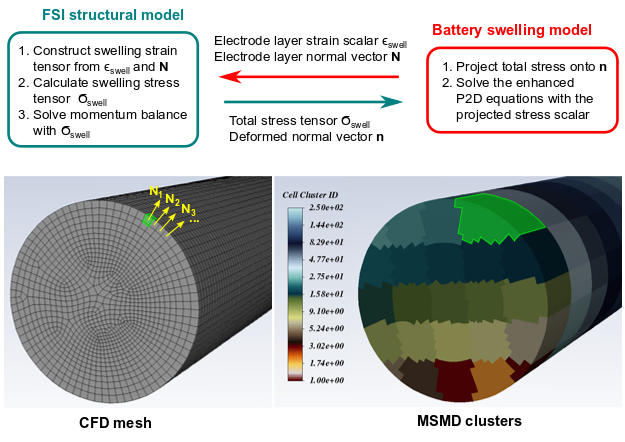When the MSMD battery model is coupled with the fluid-structure interaction (FSI) structural model, the electrode layer deformation is provided by the battery submodel, while the macroscale battery cell deformation is solved by the FSI structural model. The model coupling methods are adapted from [729] and are shown in Figure 19.7: Coupling of the Swelling and FSI Structural Models.
For the Newman's P2D model, the coupling between the structure and battery models is two-way. This kind of coupling is more comprehensive as further described.
During the simulation, the battery swelling model calculates the effective strain induced by the swelling of the battery sandwich layer embedded within the CFD control volume and passes it to the structural model. In its turn, the structural model calculates the effective external pressure exerted on the battery sandwich layer and passes it to the battery swelling model. In addition, since the battery swelling model is one-dimensional while the FSI structural model is three-dimensional, a directional information (that is, the normal vector of the electrode layer) is passed between the two models to convert the coupling variables back and forth between scalars and tensors.
Figure 19.7: Coupling of the Swelling and FSI Structural Models illustrates two different levels of spatial resolutions of the coupling variables. The FSI structural model is solved on the CFD mesh, while the Echem submodel is solved iteratively over MSMD cell clusters, which are CFD control volumes grouped together to save computational cost. A single CFD control volume and its corresponding MSMD cell cluster are shown in green side-by-side. When the coupling variables are passed from the battery to the structure solver, the single cluster value of the swelling strain scalar is assigned to all CFD control volumes within the cluster. When the coupling variables are passed from the structure to the battery solver, the projected stress scalar is volume-averaged among all CFD control volumes within the cluster.
When solving the E-Chem submodel, the mechanical load input of the mechanical pressure (used in Equation 19–72) is calculated as the normal
component of the total stress tensor projected onto the local electrode layer surface:
(19–76) |
where
The strain scalar of the electrode layer is calculated as the swell-induced deformation averaged over the P2D electrode
domain:
(19–77) |
where ,
, and
are the swell-neutral thickness of the negative electrode, positive electrode,
and separator, respectively. The remaining nomenclature is the same as in Equation 19–72.
The enhanced P2D model is then solved using Equation 19–64 through Equation 19–67. The strain scalar and the reference frame normal vector
are then passed to the FSI structural model. The FSI structural model solves
the battery geometry deformation and passes the resulting total stress
and the deformed frame normal vector
back to the Echem submodel.
For the NTGK/DCIR and ECM models, the coupling between the structure and battery solvers is
one-way. Just like in the case with the physics-based swelling model, the swelling strain
and the reference fame normal vector
are passed to the structure solver. However, the structure solver does not
pass anything back to the battery solver.
Note: The solutions of the FSI structural model satisfy the solid mechanics momentum balance with swelling stress included and are affected by the solid materials properties (such as strain-stress relation and boundary constraints). For more information, see The Structural Model for Intrinsic Fluid-Structure Interaction (FSI). For details about coupling formulations and vector transformation in the FSI structural model, see Coupling of the Structural Model with the Battery Swelling Model.



